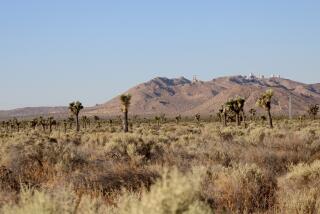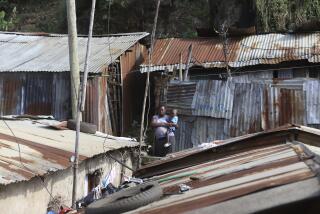Skyscraper Prompts an Environmental Uproar : Kenya: The furor over the proposed high-rise in Nairobi is unusual for two reasons: Progress is rarely opposed, and political debate is almost non-existent.
- Share via
NAIROBI, Kenya — When the plans were first unveiled last month for what was to be the tallest skyscraper in Africa, few voices questioned the Trump-scale hype.
“Trendy and magnificent,” it was called. “The most prestigious in the whole of black Africa.”
That is all different now. Today the planned 60-story, glass-sheathed tower designed to house Kenya’s quasi-official Kenya Times newspaper is the leading environmental issue here.
The last few weeks have seen mushrooming opposition to the way the tower is likely to pare a huge chunk out of Nairobi’s Uhuru Park, the city’s most popular recreation spot, and to cast a chilling shadow over what remains.
Letters to local newspapers are virtually unanimous against the project. The country’s association of professional architects has damned the British-designed, and part British-owned, complex.
It is a controversy remarkable not only for its mere occurrence in a place where political debate is almost nonexistent, but also because it has placed Kenya’s ruling party--which owns more than 50% of the newspaper and the building--in the unaccustomed position of facing the business end of a public uproar.
The affair even could develop into an embarrassment for President Daniel Arap Moi, who cherishes his international reputation as an environmentalist, derived in part from his stance against the international trade in elephant ivory.
Still, upon his return from a recent trip to Europe, Moi devoted part of his homecoming speech--which he often uses to make important political pronouncements--to supporting the project.
“Shut up, Moi Tells Critics of Complex,” was the headline in the Kenya Times the next day.
Grass-roots movements to protect the urban quality of life are not unusual in the developed world. Local outrage over how an immense skyscraper would cast a shadow over New York’s Central Park helped kill that design two years ago, and a campaign against the architectural pollution of London’s skyline is spearheaded by none less than Prince Charles.
But such public debate is rare in sub-Saharan Africa, where the existence of more than 25 one-party states helps confine genuine participatory democracy to the political science texts.
The Kenya Times complex dispute also illustrates how environmentalism tends to be seen as a luxury issue in places like Africa, where economic development is so meager that any industrial activity gets a green light. The result has been zones clouded by smelting pollution, like that of the copper district of southeastern Zaire, and entire cities shadowed by the smoke of burning wood and charcoal.
Credit for what may be Africa’s most remarkable exercise in environmentalism belongs to Prof. Wangari Maathai, a 49-year-old anatomist and ecologist. Maathai operates her grass-roots environmental agency out of a seedy wooden barracks about a half-mile from the tower site.
The so-called Green Belt Movement she founded is chiefly devoted to helping Kenyans plant trees in their increasingly bare localities. Her experience running the group for 14 years makes her no stranger to ventures as quixotic as the fight against the Kenya Times tower may turn out to be.
The movement initially hoped to plant 15 million trees, one for every Kenyan then living. (The rapidly growing population is now 23 million.) The ambitious goal provoked the then-chief conservator of forests to laughter, and he offhandedly told her the group could have all the seedlings it needed, free of charge.
Within a year the demand was so overwhelming that the department had to start charging for the trees.
“Nobody took us seriously at all,” Maathai recalled. “Well, that is typical. First of all, we are women.”
But in the succeeding 14 years, the Green Belt Movement has planted more than 20 million trees in Kenya--3.5 million last year alone. It has 600 workers in the field promoting its agricultural vision and motivating local women’s councils to set up the village and town organizations that are necessary preludes to tree-planting programs.
Maathai’s current crusade began some weeks ago, when she noticed a galvanized tin fence closing off a large corner of Uhuru Park. “I thought they were just preparing the park for a religious crusade,” she recalls.
The fencing was followed by a series of public announcements about the scale and terms of the coming construction: The complex would include a tented auditorium and several smaller buildings. It would be part-financed and part-owned by Robert Maxwell, the British tabloid publisher who owns the Kenya Times in partnership with the Kenya African National Union, the country’s sole party.
And, although the complex was ostensibly private, its bank financing would be backed up by a $130-million loan guarantee from the government.
Maathai criticized the location of the project in several letters to KANU officers. Not one was answered. Eventually parts of the letters were published, and the dispute went public.
What followed provides a look at how dissent is handled in one-party Kenya--even dissent articulated through legitimate channels.
Soon after Maathai’s complaints were published, parliament interrupted its regular business to engage in a popular ritual of Kenyan politics: the wholesale vilification session. Usually lasting the better part of an hour, these ceremonies generally target in absentia some real or perceived enemy of Kenya. Recent targets have been the entire nation of Uganda and Ethel M. Kennedy, who had questioned the country’s human rights record.
This time the target was Maathai. One member after another took the rostrum to crack crude jokes at her expense, question her patriotism and marital status and to wax indignant over her appeal to the British ambassador to communicate her protest to Maxwell.
A few days later, some of the MPs asked that Maathai’s Green Belt Movement be banned, on grounds that its finances were not public.
“They probably think that I am like them, misappropriating money,” she remarks. Kenya’s acting attorney general replied that there was no legal basis under which to take such a step.
But Maathai has given as good as she gets. “At another time and another format, I would pick up the debate on my marital status (she is divorced) with the honorable members,” she wrote in reply to the Parliament session. “For this time, the debate is on the proposed Times complex at Uhuru Park, and the debate should not be distracted by the anatomy below the line. The debate requires the anatomy of whatever lies above the neck.”
When MP Sharif Nassir, a high KANU official who for years has been Moi’s political representative, challenged her as anti-government, Maathai fired right back in an open letter: “Why is it that every time a citizen expresses an opinion, you call upon the government to silence them? What are you protecting, if not your own personal interests?”
“People have been almost scared for me,” she says nonchalantly. “I tell them that under the law, I am free to disagree with the members of Parliament.”
The spectacle of this lone academic standing firm seems to have stiffened the resolve of the Kenyan press, which tends to be supine in covering KANU affairs. Some editorials have attacked the construction; last week’s Weekly Review, a literate magazine that is the closest publication here to Time or Newsweek, ran two pages of reader letters on the issue. Unanimously, they opposed the building.
If the tower controversy is notable as a rare exercise in environmental consciousness-raising, it is also a harbinger of what may happen as Africa becomes increasingly urbanized and its open land disappears. In 1960 sub-Saharan Africa had three cities with more than 500,000 people; today it has 28. Most of these have grown willy-nilly, with scant planning effort and little attempt to provide necessary services, much less common amenities.
To a certain extent Nairobi is unusual in this group, with extensive city services and a number of well-kept parks. Only one of these, however, is conveniently accessible by bus for most of the city’s poor families seeking a day’s outing: Uhuru Park.
Dotted with fountains and reflecting pools and located on a large, gently sloping hill on the edge of Nairobi’s bustling downtown, Uhuru Park is by far the most popular weekend gathering place for Nairobi natives.
“I see people there who have no other forms of recreation,” one Nairobi resident wrote to the Daily Standard newspaper, “men with wives and barefoot children but happy to have those moments of tranquility when they can forget the struggle of daily living.”
Over time, the park has steadily shrunk, however. Once part of a miles-long strip of greenery along downtown Nairobi’s western edge, it has become enclosed by new skyscrapers and progressively less isolated from the city’s smoky traffic.
At one end, the fields have been given up for a major football stadium and a members-only golf course; at the other, the land has been taken over by the University of Nairobi for athletic fields and by a government “children’s traffic park”--almost always empty--where bicycle riders can pedal within a miniature neighborhood.
Not long ago, the government allowed one of Nairobi’s leading hotels to build a terrace out into the park, and last year a large chunk of greenery was excavated for the so-called Nyayo monument, a squat, black-granite pedestal topped by a fist gripping a torch. The monument commemorates Moi’s 10th anniversary in office.
“Now to take the only part that is left is really to slap the public in the face,” Maathai says. “Especially because the population has grown so much, the housing estates are so overcrowded there are no playing grounds for children. Nobody cares where the ordinary people can go out and rest.”
More to Read
Sign up for Essential California
The most important California stories and recommendations in your inbox every morning.
You may occasionally receive promotional content from the Los Angeles Times.












